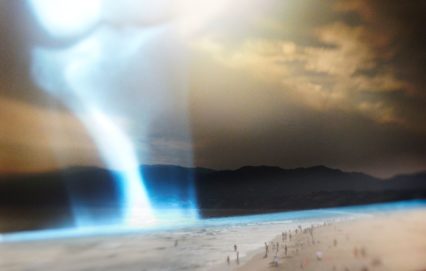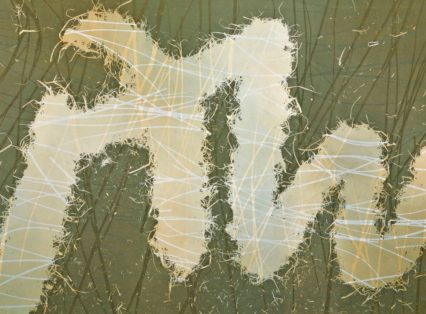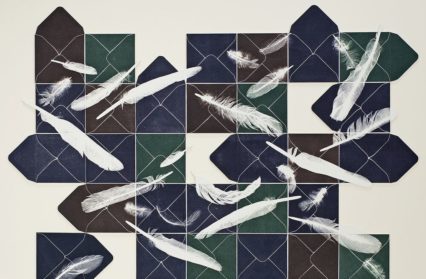Karen Westendorf is at the Aberystwyth Arts Centre to cast a critical eye over Inside Out: From Vegas to Wales, an exhibition by Linda Alterwitz and Ruth Thomas.
Linda Alterwitz and Ruth Thomas have been friends for 30 years. They first met when the former walked into the studio of the latter at Lady Lodge Arts Centre in Peterborough in 1986 in search of a space to work in. With both being at the start of their careers and seeing that their art had much in common, they got on very well. They ended up sharing a studio and exhibited together in some obscure venues such as the Elephant & Castle Shopping Centre in London. Alterwitz returned to the United States, her native country, in 1989 and they didn’t meet again until 2000. However, they kept in touch and noticed the similarities in their works, for example, with regard to the layering of materials and images and their approach to their respective environments. This eventually generated the idea to organise an exhibition together.

Although both started out primarily as painters, the friends developed in different directions. Alterwitz ventured into digital photography. Her idea to swap the brush for a camera after twenty years of painting was the feeling that she was very much “behind the times” as she calls it. She took classes on digital photography and “wanted to get to the point where I knew more than my children”- a goal which she thinks she achieved.
Alterwitz explains that she also found a benign tumour about twenty years ago, and that she was “fascinated by the images that were inside of my head; that revealed what’s beneath the surface of our body,” when the doctor handed her the MRI scans of her brain. This experience got her interested in medical imagery. For the first six months or so, working with such images, she admits, was part of the healing process after her ordeal. After that, for at least the last fifteen years, it has been the ongoing captivation of unveiling the unseen which is – nevertheless – essential to our lives. Starting with juxtaposing her photographs of beaches and other familiar landscapes with microscopic images of algae, which she received from a researcher, she soon moved on to canine x-rays, which her vet gave her. Finally, she began creating images including human medical imagery.
The result of the combination of scientific images and the artist’s photographs – expertly done with the help of Photoshop – is mysterious and sometimes outright startling. Having had a look at works such as Untitled #2 and Untitled #5 of the Discarded Dreams-series before the artist starting explaining their background, I found my thoughts circling around end-of-the-world movies such as Deep Impact, Mars Attacks or Armageddon. The scenes are reminiscent of aliens attacking or comets about to crash into and destroy our planet. Alterwitz enjoys the ambiguity that her images create and when viewers are curious about why the beach dwellers are gathering in Untitled #2 and what they are looking at. What I imagined to be an outer space laser that fires into the sea actually turns out to be a canine x-ray. The unsettling presence in Untitled #5 is also nothing more threatening than microscopic algae rather than a comet about to collide with Earth.
Whereas the above examples evoke futuristic visions, others create a more melancholic, subdued atmosphere. Linda Alterwitz’s project While I am Still shows, amongst others, translucent human figures in different settings. The processed medical images are scans of patients being tested for cancer. As Alterwitz expounds, a slightly radioactive liquid is injected into the body. It highlights the cancerous areas whilst the person has to lie very still in the MRI scanner. This time of immobility inspired the name of the project. During the procedure questions such as “What’s happening to me?” and “Am I okay?” might arise; “Can I still enjoy walking the dog along the beach? Can I still visit the funfair with my family?” (Untitled #16). Other patients might envision themselves in a field of sunflowers beneath wide open skies such as in Untitled #13 to blend out their scary, claustrophobic situation inside the machine. As the artist rightfully points out “We all have times of physical and emotional turmoil”, and cancer certainly interrupts everyday-life, leaving the patient betwixt fear and hope for the future. This kind of anxiety is captured in Untitled #34 in which a body is entangled and entrapped in the dry and bare branches of a large bush.
Alterwitz was inspired by the twigs’ “elements of fragility” which could be compared to the fragility of the human body. I often think that ‘transience’ is a very overused word in art, but for the While I am Still -project no expression could be more apt. Neither the human bodies nor the surroundings they are set in seem completely palpable; they are each depicted at a fleeting moment in time; both will live, change and wither with the seasons; collect memories and linger on in memories for a while, only to sink into oblivion in the end.
The artist explains that by combining medical pictures with other photos, a new image evolves and “something happens.” The moment she realises that this “something” has happened, she stops manipulating the work: “There it is. It’s done.” She is not prescribing an unshakable reading for her works, but is quite content when observers interpret them their own way and voice their own opinions and thoughts. Maybe these juxtapositions of the human body and the environment prove that we are ultimately conjoined no matter how advanced our technology and how much we think we have our bodies and lives under control. Making the unseen visible, revealing things small and seemingly insignificant changes our perception and can make the familiar extraordinary and uncanny.

Ruth Thomas also focuses on the hidden or little things in our lives and environment, but in a different way to her friend. Growing up in Easton-on-the-Hill, a small village on the borders of Lincolnshire and Northamptonshire, she walked the country lanes with her friends, collecting interesting little objects. She thus developed a great love for nature, and, after having spent eighteen years in urban areas, now lives in North Wales, happy to be back in a more rural neighbourhood which she keeps exploring. However, opposed to the modern photographic images of Linda Alterwitz, Thomas specialises in the ancient art of printmaking. She picks up feathers, seeds, leaves, etc. and eternalises them in collagraphs such as Anthology II and An Acorn and a Rusted Bolt I. During a three-months residency at Bodelwyddan Castle and Park, Denbighshire, in 2006, for example, she encouraged visitors to collect objects on the premises for her to create prints with them. In exchange, the contributor would receive one of the prints.
Just as Alterwitz used her works to process her experience with a difficult time in her life, Thomas used some of the exhibited works to come to terms with the death of her mother, thus creating a lasting tribute to her. The story of these prints is endearing: For one year, in 2003, every day after walking the dog, her mother would write down detailed notes about the people she met, the things she observed on the way. Then, during the time of her treatment, she wanted to transcribe them into the computer in order to preserve them and make them more accessible to the rest of her family. Her daughter assisted her with that task and became engrossed in the little stories and her mother’s tiny hand-writing. After her mother’s death, Thomas was left with these densely filled pages and felt that she had to do something with them. She decided to enlarge sections of the writing and with the help of lawn clippings or marram grass turned them into collographs and monoprints. They have poetic names such as Always the Sound of the Wind, The Dry Sun-warmed Grass and The Shadows are as Dark as the Sun is Bright. The titles are made up from words taken from her mother’s jottings. They recall sunny afternoons walking the dogs and the smell of freshly cut grass drying in the fields, and bring to life the stories that her mother so assiduously accumulated.
However, they only really stir up these sensations when the observer knows the background of them; otherwise it takes a lot of imagination to figure out what the ‘squiggles’ in the images are and their actual meaning. From the start, the prints attracted me visually with their strong colours of green and orange, but I took the enlarged hand-writing for threads of wool and hence couldn’t make any connection to the titles. Thomas explained that she abstracted the manuscripts on purpose, remarking: “I often find it quite distracting to have legible writing in a piece of art, because I find I have to read what is written. It distracts me from the whole work.” I can certainly see her point, but for me, a dog owner myself, the images were much enriched by knowing their full history.
Other works by Thomas also deal with loss and memories, but as well in an uplifting and hopeful way: prints such as Message Board I and Messages II tell the fable of white feathers representing messages from angels – loved ones that have left us behind. The artist heard a woman, who strongly believed in this rather heart-warming story, talking about it on the radio and took it as an inspiration. To emphasise on the idea of feathers as messages, she includes envelopes as well in the resulting images. To a printmaking novice, the fact that she managed to reproduce those feathers so faithfully might appear mind-boggling. Just as with her other works, there are no splodges or blurred lines that would disturb the overall harmony of the images. A friend of mine, who just finished her Masters in fine art and is a printmaker in her own right, was also very impressed by the technical accomplishment; this includes the expert handling of different layers of colour in, for example, Fan Worm Fossil Form and Haitian Boa II. The latter is an imprint of a real snake skin which was kindly provided by an acquaintance who works at Bangor University and whom she had originally met during her residency at Bodelwyddan Castle and Park. It is, of course, beyond question that the images can be enjoyed without the background stories. However, being aware of their origins makes a visit to this exhibition even more rewarding.
The exhibition Inside Out: From Vegas to Wales is now on at the Aberystwyth Arts Centre until the 18th June 2016. For more information, please visit https://www.aberystwythartscentre.co.uk/ or the artists’ websites: www.lindaalterwitz.com and www.ruththomas.net
(header image: ‘Messages II’ by Ruth Thomas 2016)












